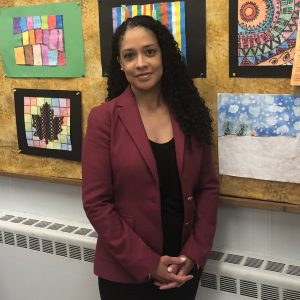Sarhanna Smith, a student in the Executive Leadership Program (ELP) at the University of Connecticut, works hard to maintain an academic and professional career as both a full-time student and Principal of Read School in Bridgeport, CT. Smith’s teaching journey began in 1994 with her very first teaching position in grade three in Washington, DC, and then teaching first and second grades at an interdistrict magnet school in Connecticut run by Area Cooperative Educational Services (ACES). She later taught older students who were identified as struggling readers. After earning her Master of Science in Reading in 2003, Smith became a literacy coach for the interdistrict magnet school. Through her work as a literacy coach, she worked with a district-wide committee to co-author the Scientific Research Based Interventions (SRBI) plan for the school district. In 2012, as a student in the UConn Administrator Preparation Program (UCAPP), Smith earned her sixth-year diploma in educational leadership and became assistant principal of Thomas Edison Magnet School in Meriden, CT from 2011 to 2013, then of Hamden High School in Hamden, CT from 2013 to 2014. She has been principal of Read School since 2014.
Smith’s commitment to education goes above and beyond teaching. She is actively engaged with district-wide committees, teacher organizations, and she challenges Connecticut to take action towards social change. Working to make her district stronger by “focusing beyond just the school level,” as Smith says, is vital in her success as an administrator. Another of Smith’s pursuits is part of Educators for Excellence-CT, a teacher-led organization out of Bridgeport, CT, whose objective is to make different routes to certification fair and accessible to teachers of color. In its beginning stages, Smith had the privilege of taking part in the creation of Educators for Excellence-CT’s policy paper, which has already grabbed the attention of the CT legislature and governor. But attention, Smith notes, is not enough: social change and action are needed to give qualified teachers of color access to available teaching positions. Smith is a firm believer that students learn best when exposed to content they can identify with and as a result, are able to connect to teachers who care about them, share and respect their social identities, and represent a more diverse population of educators.
To other student-professionals, Smith emphasizes the importance of building a strong support network and connecting with others within your professional cohort. Smith advises other working mothers like herself to never give up and seek the support of peers and professionals within your cohort. As a student-professional, Smith understands the importance of time management. She believes she is strengthened both as a professional and as an individual pursuing a career in executive leadership as well as continuing her education as a full-time student. By holding a leadership position, Smith sees it a priority to be an example of hard work and ethics to her students. Smith says,
“Young people are constantly watching and learning from the adults around them”
and as a result, you are responsible for setting a good example for your students as well as for other up-and-coming professionals in the field.
Whether it’s principal, student, or committee work, she admits,
“There’s never a time when I have no work to do.”
